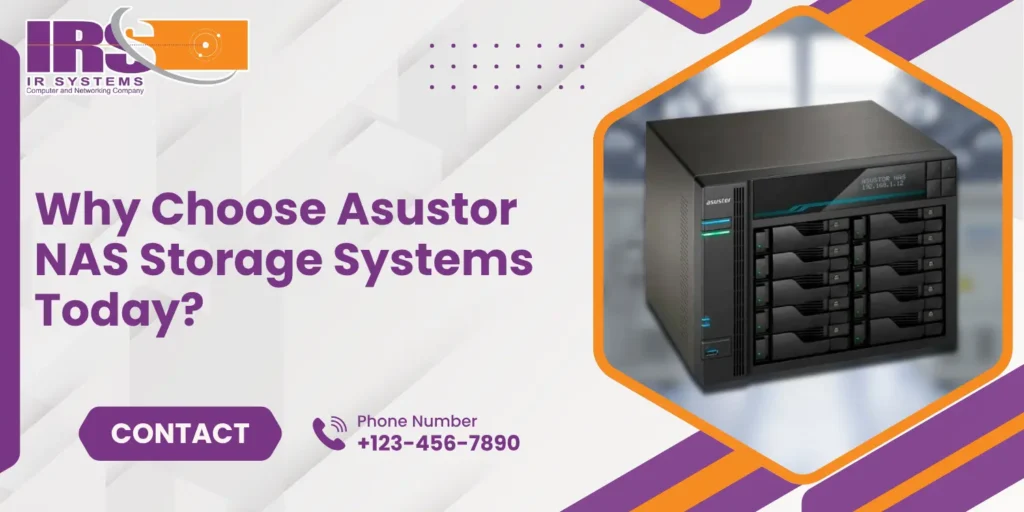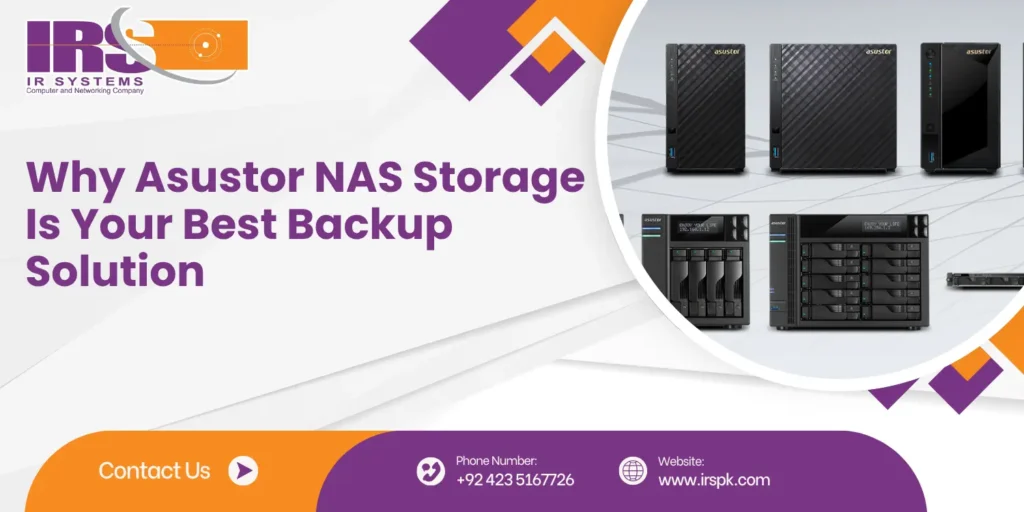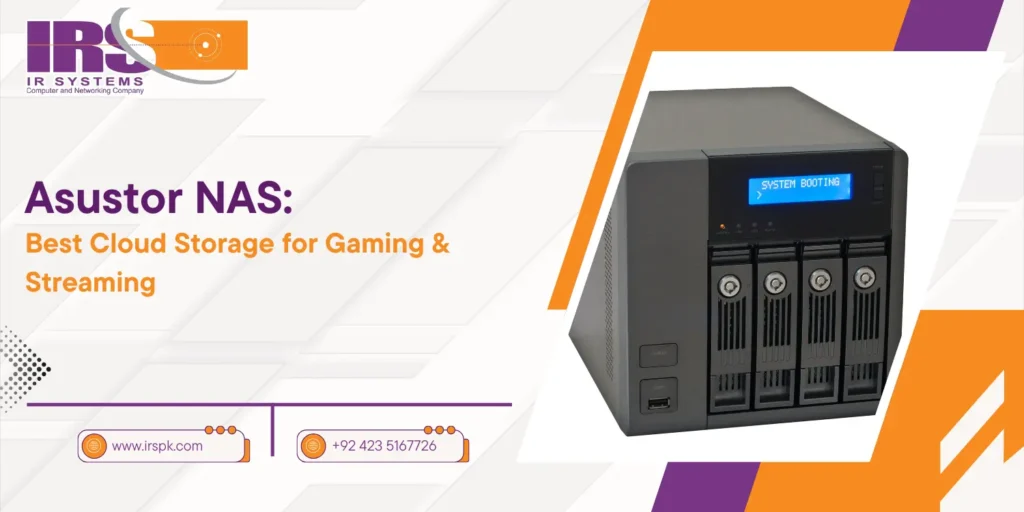Why Choose Asustor NAS Storage Systems Today?

In the modern digital world, data isn’t just information – it’s your business’s backbone. Whether you’re managing files, media, or sensitive client information, having the right storage solution is critical. That’s where Asustor NAS storage systems come into play. At IR Systems, we understand how vital it is for businesses to have dependable, secure, and scalable storage. With the increasing demand for efficient backup data storage and server cloud backup options, Asustor has emerged as a top choice for small businesses, enterprises, and even tech enthusiasts. In this blog, we’ll walk you through what makes Asustor special, why it stands out among NAS storage providers, and how it can benefit your organization today and in the future. What Is Asustor NAS Storage? Asustor is a leading brand in the NAS (Network-Attached Storage) industry. Their devices are designed to help users store, manage, and access data efficiently from anywhere in the world. But what truly sets Asustor apart is its combination of user-friendliness, powerful performance, and advanced features tailored for both business and personal use. An Asustor NAS storage system functions like a private cloud, enabling multiple users to store and retrieve data over a network securely. From backing up business-critical files to hosting servers and media libraries, Asustor offers unmatched flexibility and reliability. Why Businesses Need NAS Storage Today With the rise in remote work, cyber threats, and massive data consumption, traditional storage methods like USB drives and external HDDs are no longer sufficient. Businesses need: Centralized data access for team collaboration Automated backup data storage to prevent data loss Secure server cloud backup to protect against ransomware or system failures Scalable storage systems that grow with your business This is exactly where Asustor NAS storage delivers. Top Reasons to Choose Asustor NAS Storage Systems Asustor NAS storage systems offer powerful, secure, and scalable solutions for modern data needs. Here’s why they’re a top choice for businesses today: 1. Blazing-Fast Performance Asustor devices are built for speed. Equipped with Intel processors, NVMe SSD caching, and 2.5GbE/10GbE network interfaces, they offer ultra-fast data access. This is ideal for businesses that need rapid file transfers, real-time video editing, or quick database queries. 2. Reliable Backup Data Storage One of the primary uses of Asustor NAS is automated backup. Whether you’re backing up Windows, Mac, or Linux systems, Asustor makes it easy with tools like: Snapshot Center – Take point-in-time copies of your data. Cloud Backup Center – Integrate with services like Dropbox, OneDrive, Google Drive, and Amazon S3. Remote Sync – Schedule secure backups to remote locations. This makes it a solid option for any organization seeking secure backup data storage without breaking the bank. 3. Scalable Server Cloud Backup Start small and scale up – Asustor supports multiple drive bays (from 2-bay to 16-bay options) and can expand storage with additional units. Plus, with features like MyArchive, you can hot-swap drives for offsite storage. This makes server cloud backup flexible, reliable, and future-ready. 4. Business-Ready Features Asustor doesn’t just offer storage – it provides smart tools for business productivity, including: Virtual Machine support for running multiple OS environments Surveillance Center for integrating IP cameras Web server hosting and Docker container support This makes it much more than a storage device – it’s a complete server solution. 5. Strong Security Protocols Security is non-negotiable. Asustor NAS storage systems come with: AES 256-bit encryption Two-step authentication Auto-blocking for suspicious IP addresses HTTPS connection and firewall controls These features ensure that your data is protected from both internal mishaps and external threats. How IR Systems Helps You Deploy Asustor NAS At IR Systems, we don’t just sell hardware – we deliver complete NAS storage solutions. Our team of experts will assess your data requirements, help you select the best Asustor model, and ensure smooth deployment with ongoing support. We work with businesses across Pakistan to implement Asustor NAS systems tailored to their needs. Whether you require a powerful 4-bay device for your creative agency or a rackmount 16-bay server for your corporate data center, we’ve got you covered. Who Can Benefit from Asustor NAS Storage? Small and Medium Businesses (SMBs): Manage files, emails, backups, and software in one place. Educational Institutions: Store student data, assignments, and digital content. Creative Professionals: Host large media files, edit directly from NAS, and maintain archives. Home Users: Create a personal cloud, stream media, and protect family memories. Conclusion: Why Asustor NAS Is the Right Choice In a fast-paced digital age, you need a storage solution that is secure, fast, and adaptable. Asustor NAS storage systems offer exactly that – a powerful combination of reliability, scalability, and smart functionality. Whether you’re a startup looking to back up essential files or a large enterprise in need of complex server cloud backup, Asustor delivers exceptional value and performance. Ready to Upgrade Your Storage? Let us help you secure your data and streamline your operations with Asustor. Contact IR Systems today for a free consultation.
Why Asustor NAS Storage Is Your Best Backup Solution

In today’s digital-first world, data is the backbone of every business – and losing it is simply not an option. Whether you’re a small startup or a growing enterprise, data backup is one of the most critical parts of your IT strategy. That’s where Asustor NAS storage steps in – a smart, secure, and scalable solution trusted by professionals around the globe. At IR Systems, we specialize in modern NAS storage solutions, and we’ve seen firsthand how Asustor helps businesses across Pakistan stay protected, productive, and ready for the future. In this blog, we’ll explore why Asustor NAS storage systems are becoming the go-to choice for backup data storage, how they support server cloud backup, and how they can transform your backup strategy – without breaking your budget. Why Should You Care? Asustor is a leading name in the NAS (Network Attached Storage) space, known for delivering high-performance, user-friendly, and reliable storage solutions. NAS is essentially a storage server that connects directly to your network, making it easy to access, share, and secure your data from multiple devices. What makes Asustor NAS storage different is its blend of powerful hardware, intuitive interface, and advanced data protection features – all wrapped in a cost-effective package. If you’re tired of juggling USB drives, external hard disks, or worrying about ransomware attacks, an Asustor NAS might be exactly what your business needs. Why Businesses Need NAS for Backup Data Storage Imagine this: one of your team members accidentally deletes a key client file, or your main server crashes due to a power surge. Without a robust backup system, that data might be gone forever. This is where backup data storage using Asustor NAS systems becomes essential. Top Benefits of Using NAS for Backups: Automatic and Scheduled Backups Set it and forget it. Asustor lets you automate backups on a schedule that suits your needs – daily, weekly, or even hourly. RAID Support for Redundancy Asustor NAS supports various RAID levels, meaning your data is mirrored across multiple drives. If one fails, you don’t lose your information. Remote Access and Server Cloud Backup Access your files from anywhere, anytime – whether you’re at home, in the office, or on the move. Asustor supports integration with public cloud services like Google Drive, Dropbox, OneDrive, and more. Military-grade Encryption Keep sensitive business data secure with built-in encryption and multi-level access control. How Asustor NAS Storage Systems Stand Out There are many NAS brands out there, so why are businesses choosing Asustor? Let’s take a closer look at the features that set it apart. 1. User-Friendly Interface The ADM (Asustor Data Master) operating system is sleek and intuitive – even for non-technical users. You don’t need an IT background to manage your files or set up a backup job. 2. Fast Performance With powerful CPUs and expandable RAM, Asustor devices deliver lightning-fast read/write speeds – even when multiple users access data simultaneously. 3. Expandable Storage Start small and grow big. Asustor NAS systems allow you to add more drives as your storage needs increase. 4. Energy Efficient Asustor NAS devices consume less power than traditional servers, making them a green and cost-effective backup solution. 5. Cloud Integration Hybrid cloud support gives you the best of both worlds – on-premise speed and cloud flexibility. It’s ideal for server cloud backup strategies. Real-World Use Cases: How Businesses Use Asustor At IR Systems, we’ve implemented Asustor NAS storage systems across various industries. Here are a few examples of how different sectors benefit: Healthcare Providers Securely store patient records, appointment histories, and lab reports with full compliance. Asustor’s encryption and access controls ensure sensitive data stays protected. Retail and E-Commerce Manage inventory files, sales records, and customer data centrally. Sync with cloud services for added redundancy. Educational Institutions Back up course material, student records, and administrative documents in one place – accessible to staff from anywhere. Small Businesses and Freelancers Affordable, secure, and easy to use. Even solo entrepreneurs can benefit from automatic data backups and secure remote access. Asustor and Server Cloud Backup – A Perfect Match One of the best features of Asustor is its seamless support for server cloud backup. This hybrid approach combines the safety of local NAS with the scalability of cloud storage. You can back up critical data to your NAS and then set up automated synchronization with services like: Amazon S3 Dropbox Microsoft Azure Google Drive OneDrive This gives you double protection – even if your local NAS faces issues, your data is still safe in the cloud. Why Choose IR Systems for Your Asustor NAS Setup? Choosing the right NAS is just the first step. Setting it up properly, securing it, and optimizing it for your needs is where the real value comes in – and that’s where we help. At IR Systems, we don’t just sell storage solutions. We design, install, and manage complete data protection strategies tailored for your business. What You Get with IR Systems: Expert consultation to choose the right Asustor NAS model RAID setup and performance optimization Cloud backup configuration Ongoing support and updates Friendly, local service you can trust We’ve helped businesses across Pakistan protect their data, reduce downtime, and achieve peace of mind – and we’d love to help you too. Final Thoughts: Back Up Smart with Asustor & IR Systems In a time where data is your most valuable asset, there’s no room for uncertainty. Asustor NAS storage offers a powerful, secure, and budget-friendly way to safeguard your files, support remote work, and integrate seamlessly with your cloud backup strategy. Whether you’re a small team or a growing enterprise, you deserve backup systems that work reliably and effortlessly. Let IR Systems be your trusted partner in building a smart, secure, and scalable backup solution with Asustor. Ready to Back Up with Confidence? Protect your business the smart way. Contact IR Systems today for a free consultation and let us help you choose the best Asustor NAS solution for your backup needs.
Top SAN Storage & Area Network Devices 2025

In 2025, businesses are more data-driven than ever before. Every click, transaction, video upload, or software update generates data—terabytes of it. To handle this data explosion, companies are turning to SAN storage. A Storage Area Network (SAN) is a high-speed, dedicated network that provides access to consolidated, block-level storage. It’s built to support enterprise workloads that demand performance, redundancy, and scalability. This blog explores the top storage area network devices shaping the future of enterprise data storage. We’ll discuss leading models, evolving technologies, and how integrating server cloud backup and Asustor NAS storage systems can help your business grow efficiently and securely. What is SAN Storage and Why Does It Matter in 2025? A storage area network (SAN) connects servers to storage systems, ensuring high-speed data access and centralized management. In 2025, SAN is more relevant than ever due to: Increased cloud workloads Remote and hybrid work environments Real-time analytics and AI processing Demand for faster disaster recovery Businesses need solutions that are secure, scalable, and agile. SAN storage delivers on all fronts. Benefits of Modern SAN Storage Systems Modern SAN solutions come with a range of features that traditional systems simply can’t compete with: Ultra-fast data transfers for high-performance applications Advanced redundancy and backup to prevent data loss Centralized control of vast data pools Future-proof scalability that grows with your needs Top SAN Storage Devices to Watch in 2025 Below are some of the most powerful SAN storage devices making waves in 2025: 1. QSAN XCubeSAN XS5326 A powerhouse for enterprises, the QSAN XS5326 combines dual controllers, 25GbE connectivity, and lightning-fast performance for mission-critical environments. Key Highlights: Supports over 5PB of raw capacity Advanced virtualization support Redundant components for zero downtime 2. Infortrend EonStor GS 4024U Infortrend continues to impress with hybrid SAN/NAS solutions. The GS 4024U offers exceptional scalability and cross-platform flexibility. Best For: Media production Government and healthcare Cloud sync and backup 3. Dell PowerStore 500T Dell’s entry-level model in 2025 is ideal for mid-sized businesses needing high throughput and flexible scaling. Features Include: NVMe and SSD hybrid architecture Machine learning optimization Unified SAN/NAS integration 4. NetApp AFF A250 A robust SAN storage option optimized for AI, analytics, and high-performance computing. Performance Specs: Latency under 1ms Inline deduplication & compression Integrated cloud tiering 5. Hewlett Packard Enterprise (HPE) Alletra 5000 HPE’s Alletra series is now a leader in hybrid storage. The 5000 model excels in mixed workloads and remote backup. Top Capabilities: Built-in data services Automated workload balancing Multi-cloud integration The Role of Asustor NAS Storage Systems in SAN Networks While Asustor NAS storage systems are primarily NAS devices, many are now SAN-compatible through iSCSI protocols. In 2025, their flexibility, cost-effectiveness, and simplicity make them a key part of hybrid storage architectures. Use Asustor NAS for: Small office backups Remote team collaboration Secure file storage with cloud sync Popular model: Asustor Lockerstor 10 Pro AS7110T Server Cloud Backup: An Essential SAN Companion Data backups are no longer optional. Server cloud backup systems ensure business continuity by keeping redundant copies off-site. Integrated with SAN systems, this adds a powerful layer of protection. Benefits: Off-site disaster recovery Continuous data replication Ransomware-resistant snapshots How to Choose the Right SAN Storage Solution Choosing the right storage area network device depends on: Data Volume: More users or data = higher capacity needed Performance Needs: SSD vs HDD, RAID configurations, caching Budget: Entry-level to enterprise-class solutions Backup Integration: Cloud and on-prem compatibility Always align your SAN choice with business growth forecasts. SAN Storage vs Traditional Storage – A Quick Look Feature SAN Storage Traditional Storage Performance High-speed Moderate Scalability Easy to scale Limited Management Centralized Scattered Cost Higher upfront Lower upfront Ideal Use Enterprise/data-heavy apps Small workloads Key Industries Benefiting from SAN in 2025 Healthcare: EMRs, imaging, patient data Finance: Real-time trading, encrypted data Education: Remote learning platforms Entertainment: 4K/8K content editing & streaming E-commerce: Customer data & transaction processing Best Practices for SAN Storage Deployment Segment your storage network for security Enable encryption and role-based access Use automated monitoring tools Regularly test disaster recovery plans Invest in tech support and maintenance The Future of Storage Area Network Devices By 2030, we expect SAN systems to integrate even deeper with AI, edge computing, and fully automated data centers. Quantum storage might enter the scene—but for now, the focus is on: AI-powered workload balancing Self-healing architectures Cloud-native SAN frameworks Conclusion SAN storage in 2025 is not just a tool—it’s the foundation of a resilient, future-ready business. As data becomes more integral to success, investing in high-performance storage area network devices ensures your infrastructure is ready for anything. Whether you’re managing an SMB or a large enterprise, SAN solutions—especially when combined with server cloud backup and Asustor NAS storage systems—offer unparalleled reliability, scalability, and control. Choose wisely, stay secure, and scale smart. If you need expert guidance on choosing the right solution, don’t hesitate to contact us. FAQs What is the difference between SAN and NAS in 2025? SAN provides block-level storage and is ideal for performance-critical tasks. NAS uses file-level storage, better for shared file access. Are Asustor NAS devices suitable for SAN environments? Yes, via iSCSI configuration, Asustor NAS devices can integrate with SAN setups for hybrid storage flexibility. How does server cloud backup enhance SAN storage? It adds disaster recovery, protects from ransomware, and allows off-site data access in case of on-prem failure. What industries benefit most from SAN storage? Finance, healthcare, media production, and e-commerce rely heavily on SAN for real-time data access and security. 5. Is SAN storage expensive to implement? Initial setup costs can be higher, but scalability, performance, and reliability offer long-term ROI.
Asustor NAS: Best Cloud Storage for Gaming & Streaming

In today’s digital landscape, the lines between casual gaming, professional esports, and live streaming have completely blurred. Every session can turn into shareable content, every match into an opportunity for growth, and every stream into a career move. With this massive influx of high-definition gameplay, simultaneous recording, overlays, and audio syncing, having reliable storage is no longer optional—it’s crucial. Asustor, a name trusted in the NAS world, brings cloud-enabled storage to the forefront for creators who need power, speed, and flexibility. This blog explores how Asustor NAS storage systems are transforming the way gamers and streamers handle their data. You’ll discover which models are ideal for different setups, what features matter most in cloud storage for gaming, how server cloud backup adds extra protection, and why investing in Backup Data Storage can elevate your streaming game. The Gaming & Streaming Data Problem Learn why modern gamers and streamers face serious storage challenges—and why basic hard drives just don’t cut it anymore. Why Traditional Storage Isn’t Enough Anymore The average high-definition game can occupy anywhere from 30GB to 150GB. Now add gameplay recordings, editing files, visual assets, intros, thumbnails, and backup copies. You’re suddenly dealing with several terabytes of data—growing weekly. External hard drives can fail, SSDs fill up fast, and cloud subscriptions can get expensive and limited. Streaming platforms like Twitch and YouTube don’t store content forever. Many creators are now turning to Asustor NAS storage to manage everything from gameplay archiving to automatic uploads and multi-device access. Why Asustor Stands Out in the Gaming World Discover how Asustor NAS is more than storage—it’s a personal game server with powerful features tailor-made for streamers. Not Just a Storage Box—It’s Your Personal Game Server Asustor NAS (Network Attached Storage) systems are more than just containers for your data. They act as private servers that operate on your home or studio network and extend into the cloud. Let’s explore what makes them perfect for gamers: High-Speed Access: Many Asustor units feature 2.5GbE or even 10GbE LAN ports for ultra-fast transfers—no lag between your PC and storage. App Ecosystem: Tools like Plex, LooksGood, and Surveillance Center allow you to manage, stream, and secure your content effortlessly. HDMI Output: Certain Asustor devices allow you to connect directly to a monitor or TV, enabling playback without needing another computer. Seamless Backup: The ADM (Asustor Data Master) system allows automated server cloud backup to services like Google Drive and Dropbox. Top Features of Asustor NAS Storage Systems for Streamers Explore key Asustor NAS functions like 4K transcoding, RAID protection, and media streaming that elevate your creative workflow. Custom Features That Make a Real Difference Whether you’re a Twitch beginner or a YouTube veteran, Asustor offers core advantages you won’t find in standard storage setups: Snapshot Protection: Roll back changes or recover from data corruption instantly. 4K Video Transcoding: Stream and edit game recordings smoothly. Hot-Swap Bays: Upgrade your hard drives on the go—zero downtime. Multimedia Streaming: Built-in DLNA server, Plex support, and Kodi apps. RAID Support: Redundancy options to protect against hard drive failure. Best Asustor Models for Gaming & Streaming A quick comparison of the top Asustor NAS options to suit beginners, pros, and studios—so you can pick what works best for your setup. 1. Asustor AS5402T – Power & Speed Combo CPU: Intel Celeron N5105 RAM: 4GB DDR4 (expandable to 16GB) Connectivity: Dual 2.5GbE LAN Use Case: Streamers who edit content in-house, handle 4K footage, and need lightning-fast file transfer. 2. Asustor AS6704T – Professional Streamer Setup CPU: Intel Celeron N5105 Quad-Core Drive Bays: 4-bay with NVMe SSD caching Expandability: Upgradable RAM, dual LAN, and HDMI 2.0 support Use Case: Gaming studios or creators managing large collaborative projects. 3. Asustor Drivestor 4 Pro – Budget-Friendly Entry CPU: Realtek Quad-Core Drive Bays: 4 Connectivity: 2.5GbE Use Case: New streamers looking for affordable but effective Backup Data Storage. Server Cloud Backup: Safety Net for Your Content Asustor’s built-in server cloud backup tools make your content nearly disaster-proof. Whether you’re concerned about accidental deletion, hardware failure, or ransomware, Asustor’s multiple-layer backup strategy has your back: Hybrid Backup Sync: Automatically copy content to Google Drive, Dropbox, OneDrive, or another NAS. Remote Syncing: Easily sync between locations—ideal for traveling streamers. Multi-Version Control: Store previous file versions to protect against accidental overwrites. Encrypted Transfers: All backups are secured with AES-256 encryption. Key Benefits for Gamers & Streamers Using Asustor NAS Storage From energy efficiency to mobile access, here’s why Asustor makes everyday content creation smoother and safer. Streamlined Workflow Edit videos directly from the NAS, no need to copy them to your local PC first. Accessible Anywhere Use the AiMaster mobile app to monitor, upload, or stream content from anywhere in the world. Energy Efficient Run your NAS 24/7 without the power drain of a full gaming rig. Centralized Library Store, organize, and tag game footage, intros, clips, and other assets for easy search and retrieval. How to Set Up Asustor NAS for Streaming in 5 Easy Steps Select the Right Model: Choose based on your needs—number of drive bays, RAM, and network speed. Install Drives: Use compatible SSDs or HDDs; configure RAID if desired. Connect to Network: Plug into your router or switch via Ethernet. Setup ADM: Initialize your NAS using the Asustor Data Master platform. Install Media Apps: Add Plex, LooksGood, or any editing tools directly through the App Central. Conclusion In a world where data is king, especially in gaming and streaming, storage can’t be an afterthought. As we saw in the introduction, the volume and sensitivity of content require something stronger than an external HDD or a standard cloud account. Asustor NAS storage systems offer performance, accessibility, and backup intelligence all in one platform—giving creators more time to focus on what they love. If you’re serious about content creation and want reliable Backup Data Storage with scalable performance, Asustor is your go-to solution. It’s time to upgrade your workflow with the ultimate tool for digital creators. Whether you’re unsure which model suits your needs or
